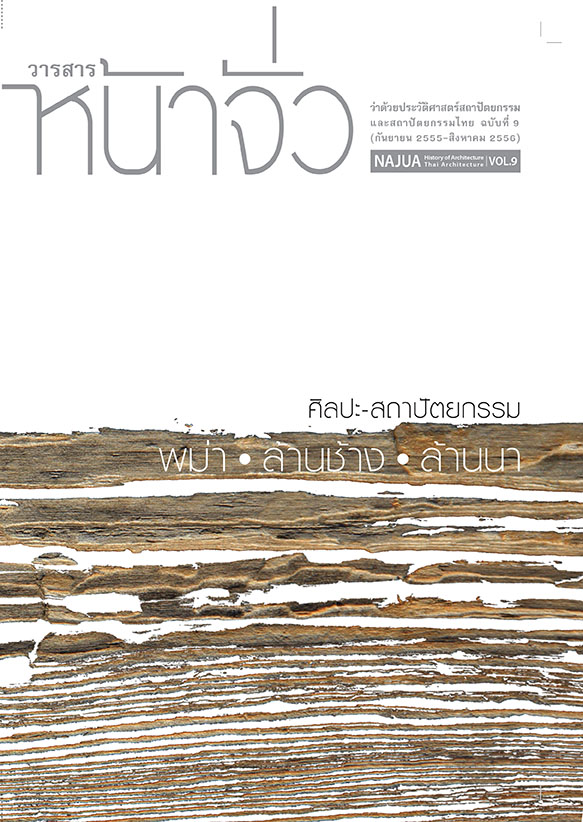ความไม่ลงรอยในเมืองเก่ากรุงเทพ : มรดก การท่องเที่ยว และเจนตริฟิเคชัน Bangkok Old Town in Dissonance : Heritage, Tourism and Gentrification
Main Article Content
Abstract
บทคัดย่อ
ความไม่ลงรอย เป็นลักษณะโดยธรรมชาติที่สำคัญอย่างหนึ่งของมรดกที่พบโดยทั่วไปในการอนุรักษ์และการจัดการสิ่งแวดล้อมทางประวัติศาสตร์ บทความนี้ตั้งคำถามในเรื่องผลประโยชน์ด้านคุณค่าทางสังคมและวัฒนธรรมของการอนุรักษ์ชุมชนเมืองจากการเข้าแทรกแซงโดยการท่องเที่ยวและปรากฏการณ์เจนตริฟิเคชันในย่านประวัติศาสตร์ของกรุงเทพมหานครในประเทศไทย ซึ่งเป็นแหล่งมรดกมีชีวิตที่กำลังดิ้นรนเพื่อรับมือกับ “คุณค่าในตัวผู้คน” ของเมืองนี้เอง ความขัดแย้งด้านสังคมและการเมือง และด้านกฎหมายบนสิ่งที่เรียกว่าอาคารมรดกของ “เมืองเก่ากรุงเทพ” ได้ถูกนำมาค้นหาผ่านชุมชนกรณีศึกษาสามแห่ง คือ ป้อมมหากาฬ เลื่อนฤทธิ์ และบางลำพู กรณีเหล่านี้เป็นตัวแทนแสดงถึงความไม่ลงรอยด้านมรดกที่ชุมชนมีต่อหน่วยงานรัฐ ต่อเจ้าของที่ดิน และภายในชุมชนเอง ทั้งการท่องเที่ยวและเจนตริฟิเคชันเป็นแรงผลักดันหลักของความขัดแย้งในบริบทนี้ ซึ่งไม่ได้ถูกอ้างถึงเพื่อกล่าวโทษแต่เพื่อขยายความในสิ่งที่ยังเข้าใจไม่ถูกต้องเกี่ยวกับคุณค่ามรดก ซึ่งสามารถนำไปใช้ร่วมกับนโยบายแบบรับคำสั่งจากเบื้องบนและการจัดการที่ไม่สนใจประเด็นละเอียดอ่อน เพื่อเห็นแก่การปกป้องรักษาความสำคัญทางวัฒนธรรมของแหล่งมรดกจึงสมควรมีนโยบายและแผนซึ่งมุ่งจัดการประเด็นคุณค่าทางสังคมซึ่งสั่งสมและงอกเงยจากตัวผู้คนในแหล่ง เพื่อให้บรรลุถึงธรรมาภิบาลด้านการอนุรักษ์ชุมชนเมืองและการจัดการมรดกที่มีความเหมาะสมและยั่งยืน
Abstract
Dissonance is by nature a significant feature of heritage, habitually recognised in the conservation and management of the historic environment. This paper questions the benefits, in terms of the sociocultural values of urban conservation, from the intervention of tourism and gentrification in the historic quarters of Bangkok, Thailand - a living heritage place that has been struggling to cope with its own ‘people value’. The socio-political and legal conflicts over the so-called heritage properties of ‘Bangkok Old Town’ were explored through the three case study communities : Mahakan Fortress, Luen Rit and Banglamphu. These cases respectively represented the heritage dissonance of a community with the authority, with the landlord, and within the community itself. Tourism and gentrification, together a major driving force of contradiction in this context, were not marked out to take the blame but rather to emphasise the misunderstanding of heritage value that can accompany top-down policies and insensitive management. For the sake of safeguarding the cultural significance of a heritage place, the relevant policies and plans should aim to tackle the social value aspects, as constituted in the people of the place, to achieve appropriate and sustainable governance in urban conservation and heritage management.

